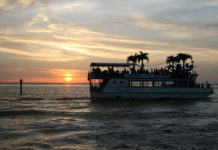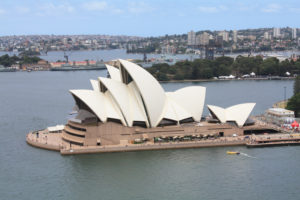
By Jill Perlin
Australia is a land of many cities, cultures and climates. Since it’s so far away, and it takes a long time to get there, it’s best to plan at least two weeks.
Here’s a sample itinerary, in which you can visit two large cities — Sydney and Melbourne — and two other popular sites — the Outback and the Great Barrier Reef. It’s important to remember one thing — Australia is in the Southern Hemisphere. So, the seasons are opposite those of the U.S.
You can begin in Melbourne. To get a sense of the city, head to the Melbourne Skydeck. You’ll ascend 88 floors in less than 40 seconds. Once you enter the Skydeck, take in 360-degree views of Melbourne through floor-to-ceiling windows. If you are a tennis fan and visit Melbourne in January, you can take in the Australian Open.
Outside of Melbourne is Phillip Island Nature Park, which has the largest little penguin colony in the world. You can watch the penguins waddle home from the ocean at night.
No trip to Australia would be complete without seeing a koala. You can do that at the Koala Conservation Reserve, which is approximately 20 minutes from the park.
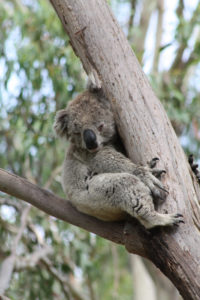
There is also the Great Ocean Road. This 150-mile stretch of road is known for its scenic views, as well as surfing, wildlife, and hiking and biking trails. Start early in the day to avoid large crowds.
From Melbourne, fly to Alice Springs, where you’ll learn about the heart of the Outback culture and ultra-remote living. Start at the Alice Springs Telegraph Station. Established in 1871, it was built to aid in communications within and outside of Australia.
The Royal Flying Doctor Service is one of the largest and most comprehensive health care services in the world and focuses on residents living in small, rural areas. Lastly, the School of the Air is a one-of-a-kind school for children there, where a teacher can be a day’s drive away.
From Alice Springs, head to Ayers Rock, which is a 4½-hour drive. Also known as Uluru, Ayers Rock is actually a massive sandstone monolith in the heart of the Northern Territory’s arid “Red Centre.” Uluru is sacred to indigenous Australians and is thought to have started forming around 550 million years ago.
Take a sunrise walk around the 7.5-mile base trail, and stare in amazement at its incredible size. At night, take a stargazing tour and learn about the southern night sky. Lastly, do a camel ride and learn how camels were introduced into Australia in the 1840s.
Next, fly to Cairns, the gateway for the Great Barrier Reef. It provides some of the world’s best snorkeling and scuba diving. Many local companies offer half-day and full-day excursions. Even if you are a novice, you’ll be wowed by the clear water, colorful fish and abundance of coral.
Outside the city, head to Kuranda. Take the Skyrail Rainforest Cableway to the top, and observe wildlife, experience the rain forest and hike one of the many trails. Ride the scenic railway back down.
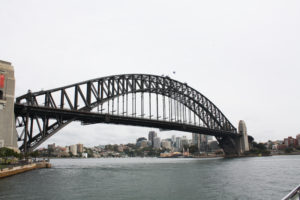
The final stop is Sydney. You can fly direct from Cairns. There is so much to see in this vibrant city.
Take a backstage tour of the Sydney Opera House. Beyond observing the Sydney Harbor Bridge, climb it! It’s one of this author’s all-time favorite travel experiences. Visit Bondi or Manley Beach, which are accessible by public ferry.
About two hours outside of the city, through a scenic ride, are the Blue Mountains. One highlight is the famous Three Sisters, an unusual rock formation in the mountains. Legend has it three sisters fell in love with three men but were forbidden to marry.
Throughout Australia, there is a wide variety of great food and drink. Seafood is always fresh and plentiful. Australia also has several wine regions worth visiting.
Lastly, Australia is well known for its zoos — Toronga and Australia Zoo, in particular. If you’re a fan of the late Steve Irwin and his family, Australia Zoo will be familiar.
There is no shortage of things to do in Australia. Many local tour companies can help you get from place to place and with individual excursions. So, you can choose to see the sites on your own, or have someone else do the planning.
Either way, you’ll find that Australia’s people, attractions, cuisine and history make it a wonderful destination. It’s worth the long flight and jet lag. And you’ll surely want to return.
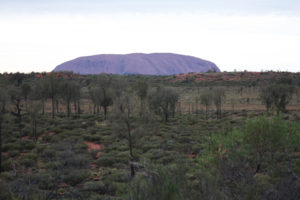
Getting Around:
By air – There are direct flights to Melbourne and Sydney from the West Coast of the U.S. Within Australia, you can generally fly to and from major cities.
By train – Australia has a large network of rail service within and outside of the large metropolitan areas.
By cruise – Several cruise lines offer sailings to Australia. Some longer sailings also include
New Zealand.
Must-Sees and Dos for a Short Trip:
In Sydney:
Take a backstage tour of the Sydney Opera House.
Visit the Sydney Harbor Bridge (if adventurous, do the Bridge Climb).
Go out to the Blue Mountains.
In Cairns:
Snorkel or dive the Great Barrier Reef.
Pay a visit to Kuranda.
If You Have at Least Ten Days:
In Sydney:
Take the public ferry to Bondi or Manley Beach.
Use public transportation to visit the Taronga Zoo.
In Melbourne:
Use a local tour operator to visit Phillip Island.
Rent a car and drive the Great Ocean Road.
Visit local wineries.
In the Outback:
Visit Ayers Rock/Uluru.
This Destination at a Glance
Over 50 Advantage: It can be expensive to do everything in Australia you might want to do. It also takes more time. It’s a vast country, and there’s a lot to see.
Mobility Level: Generally low to moderate. The Sydney Harbor Bridge Climb requires a higher level of mobility.
When to Go: Check out: travelandleisure.com/travel-tips/best-time-to-visit-australia.
Where to Stay:
Sydney – Sydney Harbor Marriott
Ayers Rock – Sails in the Desert
Cairns – Hilton Cairns
Special Travel Interests:
Aboriginal history and culture
Unique natural wonders
Jill Perlin is a freelance writer and an avid and intrepid traveler.
Jewish Australia
Like many of Australia’s early European settlers, the first Jews in Australia were transported there as British prisoners in the 18th century. An Australian Jewish presence began on Jan. 26, 1788, the day that approximately 16 Jews — 15 convicts and one baby — arrived in what is now Sydney Harbor with a large contingent of non-Jewish prisoners.
Those early Jews were the first of several waves of immigrants that would repeatedly change the Australian Jewish community, including Russians and South Africans, as well as Britons.
Despite its diversity, Jews were and remain are a tiny minority in the land Down Under, comprising about 0.4% of the first cohort of British convicts shipped off to the Australian colonies. Interestingly, that remains about the same as the Jewish proportion of the total Australian population today.
Population estimates number Australian Jews today at well above 110,000, although just 91,022 Australians identified as Jewish in the government’s 2016 census. Most live in Sydney, Melbourne and Brisbane. Melbourne has the largest contingent.
Until the 1930s, all synagogues in Australia were Orthodox, and about 70% of them remain so. There are Reform congregations in Melbourne and Sydney.
Australian Jews have played a prominent role in Australian society. The nation has had a Jewish head of state (twice), a Jewish head of the judiciary and a Jewish head of the armed forces.
The seamless integration of Jews into Australia allowed them to flourish in all spheres but religion. The Jews’ incorporation into society led to a rise in intermarriage, a drop in synagogue attendance and a lack of affiliation with Judaism in general. Nonetheless, there are still many who maintain their Jewish institutions and congregations.
Australian Jewry in the 21st century is not particularly religiously observant but has a vibrant Jewish identity. Major traditions are widespread, such as seder night at home and Rosh Hashanah and Yom Kippur at the synagogue. The community gives generously to fundraising causes and has a good record of making aliyah to Israel.
— Jeffrey Orenstein





